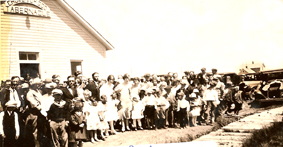Planting the Church of God in Lemmon, South Dakota
“Tuesday, Meeting here tonight…. Ruth Bishop, Joel L. Bishop, Helen Swanson, Rufus Hulbert, Father, Mother, Harold, Helga, Grace and I joined in on the Church of God tonight. Walkers, [Reinholdt] Klaudt and Helen [Swanson] stayed all night,” Clara Peterson (1905-1942) wrote in her diary on May 28, 1929.
Clara was the oldest daughter of Mr. and Mrs. Carl J. Peterson. The Petersons and their twelve children had moved to Thunder Hawk, South Dakota, in 1918. They were originally Swedish Baptists who homesteaded in North Dakota in 1906. Eventually the family became part of a Pentecostal mission in nearby Lemmon, South Dakota. Frank Burleigh was pastor of the mission, and the Peterson family attended worship there and in various homes.

Meeting in Lemmon about 1930.
Along with other “free” Pentecostals in the area, the Petersons were fearful of church organizations until they met Church of God State Overseer Paul H. Walker. Originally from North Dakota, Walker had attended the Bible Training School in Cleveland, Tennessee, and then relocated to Maryland where he served as an evangelist and state overseer. When division came to the Church of God in 1923, Walker returned to North Dakota to stabilize the situation there. Appointed state overseer of North Dakota and Minnesota that fall, he began planting churches throughout the Northwest.
In the spring of 1929, Frank Burleigh sent a telegraph to Paul H. Walker inviting him to come to Lemmon. Walker and his wife, Margaret, and their friend Reinholdt Klaudt arrived in Lemmon in late April and preached an eight-day revival. After becoming acquainted with the Joel L. Bishop and Peterson families, the evangelistic team was invited to hold meetings in Thunder Hawk. In addition to the Bishop and Peterson homes, they met in schoolhouses and borrowed church buildings until May 28 when they set in order the first Church of God in South Dakota in the Peterson home.
The new congregation worshiped in various locations for the next several months. Later that summer Walker and his evangelistic party held a successful tent revival in Lemmon with 109 conversions. Joel Bishop purchased the building where Frank Burleigh’s mission had met, and with the support of the congregation in Thunder Hawk, the Church of God began meeting there.
Since State Overseer Walker was responsible for planting churches throughout the region, the fledgling congregation needed a pastor. When the Northwest camp meeting met in Plaza, North Dakota, that July, Walker was impressed of the Lord to invite the young David C. Boatwright to pastor the Lemmon congregation. Boatwright and his wife, Elsie, had good jobs in Wahpeton, but were privately struggling with God’s call on their lives. David Boatwright had promised God that if the state overseer offered him the best church available, he would enter the pastoral ministry.
Impressed with the tearful passion of the young Boatwright’s testimony, Walker heard the Lord instruct him to invite the young man to pastor in Lemmon. Boatwright accepted and immediately began to build the congregation. Today the congregation is known as the New Hope Worship Center and remains an anchor to Pentecostal ministry in the Dakotas.
———————————————–
This article was written by Church of God Historian David G. Roebuck, Ph.D., who is director of the Dixon Pentecostal Research Center and assistant professor of the history of Christianity at Lee University. This “Church of God Chronicles” was first published in the June 2007 Church of God Evangel.




